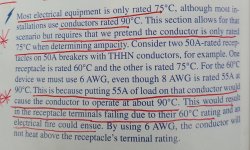I'm reading that a conductor that has a load at it it's 90 degree C ampacity will cause the conductor to operate at 90 degree C. Not a code question, but I never thought of it that way before. For instance, a 55 amp load on 8 AWG will cause the conductor to operate at 90 degree C. Seems simple but now it makes sense that you use this conductor on equipment terminals rated for 75 degree C because they will fail due to the temperature rating.
You are using an out of date browser. It may not display this or other websites correctly.
You should upgrade or use an alternative browser.
You should upgrade or use an alternative browser.
Temperature limitation
- Thread starter cppoly
- Start date
- Status
- Not open for further replies.
- Location
- New Jersey
- Occupation
- Journeyman Electrician (retired)
Where did you find this information? My assumption is that at full T310.16 ampacity the conductor operating temperature is still well below its rating.For instance, a 55 amp load on 8 AWG will cause the conductor to operate at 90 degree C.
- Location
- New Jersey
- Occupation
- Journeyman Electrician (retired)
I always thought that the NEC ampacity tables had some headroom regarding the actual operating temperature when the conductor is fully loaded. I would need to see some testing data to be convinced otherwise but thanks for providing the reference.
wwhitney
Senior Member
- Location
- Berkeley, CA
- Occupation
- Retired
Correction--the conductor may operate at 90C as the worst case expected. It would require almost all the other factors that contribute to high operating temperature to be at the worst case allowed by the NEC.I'm reading that a conductor that has a load at it it's 90 degree C ampacity will cause the conductor to operate at 90 degree C.
But because it could be 90C, you can have to consider that worst case.
Cheers, Wayne
wwhitney
Senior Member
- Location
- Berkeley, CA
- Occupation
- Retired
Most are 30C, some are 40C.Edit - I believe the NEC tables are based on 40C ambient?
Cheers, Wayne
PaulEd
Member
- Location
- United States
I'm reading that a conductor that has a load at it it's 90 degree C ampacity will cause the conductor to operate at 90 degree C.
All this means is that if you load a conductor at a higher ampacity than what it’s suppose to be limited to (typically whatever that value is at 75deg) you’re going to tax the conductor because the weakest link (the lugs) are rated at 75deg which will cause excessive heat
Christoph
Master Electrician, Code Official
- Location
- Coopersburg, PA
- Occupation
- Electrical Inspector
I think that section needs rewritten. As stated by others it is completely impossible to make a statement in a book as to the operating temperature of a conductor with a given current flow. My understanding is that the insulation is rated to operate up to the rated temperature. The copper inside doesn't change between 75degree and 90degree wire as far as I know.From A Comprehensive Guide to the 2023 NEC Volume 1 (Ryan Jackson author). The book is great btw. See below.
View attachment 2573151
The weakest link explanation is why we use the 75C calculation even if the wire is 90C. The thermal effects explanation I do agree with in the book. if you allow a conductor to operate at 90C that is connected to a 60C terminal that will overheat the terminal.
- Status
- Not open for further replies.

